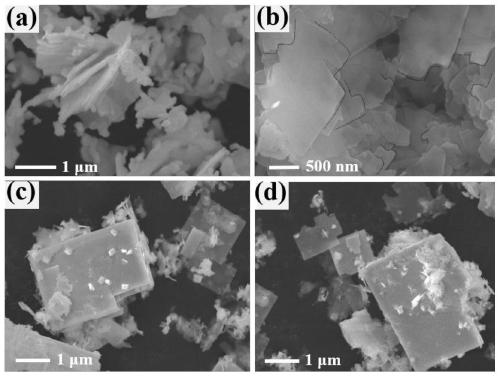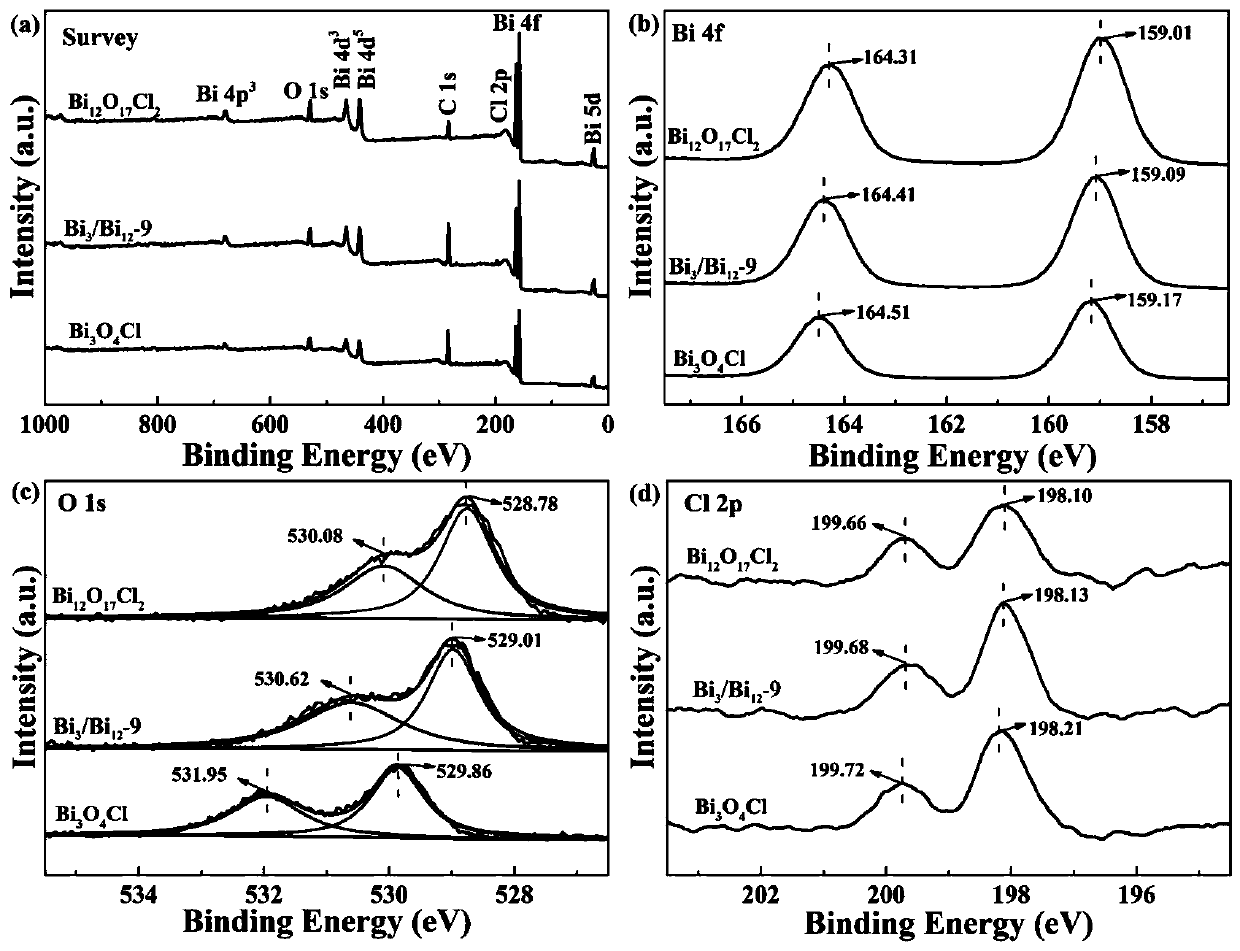A visible light responsive heterojunction composite material and a preparing method and use thereof
A composite material and visible light technology, which is applied in chemical instruments and methods, light water/sewage treatment, water/sludge/sewage treatment, etc., can solve the problems of photocatalytic activity and visible light utilization efficiency, poor degradation performance, photogenerated Poor electron-hole separation efficiency and other issues, to achieve excellent photocatalytic activity, facilitate mass production, and high-efficiency photocatalytic activity
- Summary
- Abstract
- Description
- Claims
- Application Information
AI Technical Summary
Problems solved by technology
Method used
Image
Examples
Embodiment 1
[0021] Step: Preparation of Bi 3 o 4 Cl nanosheets
[0022] First, 0.485g Bi(NO 3 ) 3 ·5H 2 O was ultrasonically dispersed in 10 mL of ethylene glycol for 10 min to obtain solution A. Next, add 0.018g NH 4 Dissolve Cl in 25mL deionized water to obtain solution B. Slowly add solution B to the above solution A to form a white turbid solution C, which is transferred to a 50mL reactor and heated at 160°C for 12h. After the reactor was cooled to room temperature, the sample was washed with water and ethanol, and dried at 60°C to obtain solid powder D. Finally, put the solid powder D in a muffle furnace, raise the temperature to 500°C at a rate of 5°C / min, and bake for 5h. Finally got Bi 3 o 4 Cl nanosheets.
Embodiment 2
[0024] Steps: One-step preparation of Bi 3 o 4 Cl / Bi 12 o 17 Cl 2 Heterojunction
[0025] First, 0.485g Bi(NO 3 ) 3 ·5H 2 O was ultrasonically dispersed in 10 mL of ethylene glycol and stirred for 10 min to obtain solution A. Next, add 0.018g NH 4 Cl was dissolved in 25mL deionized water to obtain solution B, and solution B was slowly added to the above solution A to generate white cloudy liquid C, and NaOH solution was slowly added dropwise to white cloudy liquid C to adjust pH=8 to obtain solution D, and the solution D was transferred into a 50mL reactor, and heated at 160°C for 12h. After the reactor was cooled to room temperature, the sample was washed with water and ethanol, and dried at 60°C to obtain solid powder E. Finally, put the solid powder E in a muffle furnace, raise the temperature to 500°C at a rate of 5°C / min, and bake for 5h. Finally got Bi 3 / Bi 12 -8 heterojunction materials.
Embodiment 3
[0027] Steps: One-step preparation of Bi 3 o 4 Cl / Bi 12 o 17 Cl 2 Heterojunction
[0028] First, 0.485g Bi(NO 3 ) 3 ·5H 2 O was ultrasonically dispersed in 10 mL of ethylene glycol and stirred for 10 min to obtain solution A. Next, add 0.018g NH 4 Cl was dissolved in 25mL deionized water to obtain solution B, and solution B was slowly added to the above solution A to generate white turbid liquid C, and NaOH solution was slowly added dropwise to white turbid liquid C to adjust pH=9 to obtain solution D, and the solution D was transferred into a 50mL reactor, and heated at 160°C for 12h. After the reactor was cooled to room temperature, the sample was washed with water and ethanol, and dried at 60°C to obtain solid powder E. Finally, put the solid powder E in a muffle furnace, raise the temperature to 500°C at a rate of 5°C / min, and bake for 5h. Finally got Bi 3 / Bi 12 -9 heterojunction materials.
PUM
 Login to View More
Login to View More Abstract
Description
Claims
Application Information
 Login to View More
Login to View More - R&D
- Intellectual Property
- Life Sciences
- Materials
- Tech Scout
- Unparalleled Data Quality
- Higher Quality Content
- 60% Fewer Hallucinations
Browse by: Latest US Patents, China's latest patents, Technical Efficacy Thesaurus, Application Domain, Technology Topic, Popular Technical Reports.
© 2025 PatSnap. All rights reserved.Legal|Privacy policy|Modern Slavery Act Transparency Statement|Sitemap|About US| Contact US: help@patsnap.com



